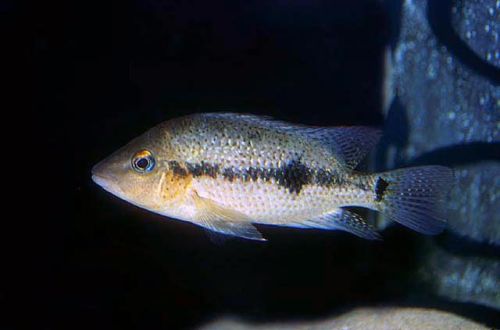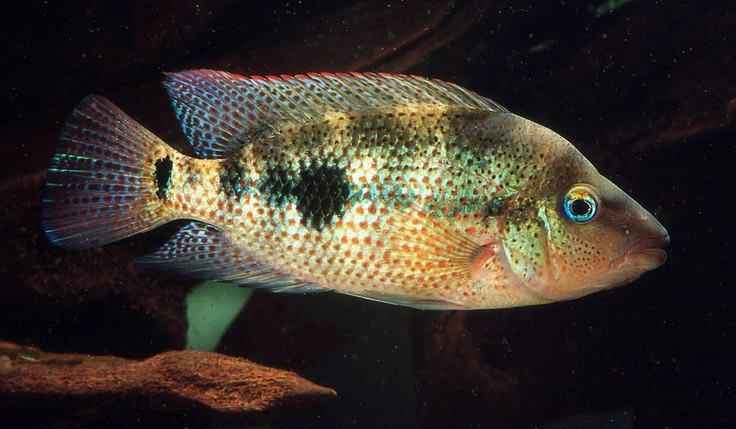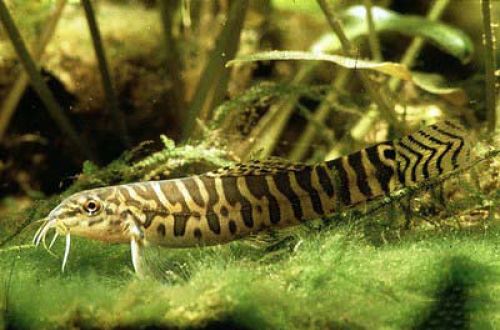
red-spotted cichlid
The red-spotted cichlid, scientific name Darienheros calobrensis, belongs to the Cichlidae family. In the past, it belonged to a different genus and was called Amphilophus calobrensis. Like other Central American cichlids, it is characterized by aggressive behavior, therefore, in an amateur aquarium, you should not keep more than one adult and it is advisable to avoid introducing other types of fish. The rest is quite easy to maintain, unpretentious and hardy.

Contents
Habitat
Distributed throughout Panama in Central America. They are found mainly in permanent reservoirs (lakes, ponds) and some rivers in places with a slow current. They live near the coastline, where they swim among rocks and crevices.
Brief information:
- The volume of the aquarium – from 250 liters.
- Temperature – 22-27°C
- Value pH — 6.5–7.5
- Water hardness – soft to medium hard (3-15 dGH)
- Substrate type — stony
- Lighting – any
- Brackish water – no
- Water movement – light or moderate
- The size of the fish is 20–25 cm.
- Meals – any
- Temperament – aggressive
- Keeping alone in a species aquarium
Description

Adults reach a length of about 25 cm. The color varies from pale yellow to pinkish. A characteristic feature in the body pattern are numerous red speckles, as well as several large dark spots starting closer to the tail. Sexual dimorphism is weakly expressed. In males, an occipital hump is sometimes shown, and the fins are somewhat longer, otherwise the females are practically indistinguishable, especially at a young age.
Food
The fish is completely undemanding to the diet. Accepts all types of dry, frozen and live food. An important condition is that the diet should be varied, that is, combine several types of products, including herbal supplements. Specialized food for Central American cichlids can be an excellent choice.
Maintenance and care, arrangement of the aquarium
The size of the aquarium for keeping one Red-spotted cichlid starts from 250 liters. In the design, it is desirable to use a lot of rocks, stones, creating crevices and grottoes from them. Gravel or a layer of small pebbles is suitable as a substrate. Plants are not needed, they are likely to be torn out, like any other loosely fixed decor element. There are no special lighting requirements.
Fish produce a lot of organic waste for their size, so maintaining high water quality is paramount. To do this, you should install a productive filtration system and regularly replace part of the water (15–20% of the volume) with fresh water, simultaneously removing waste using a siphon.
Behavior and Compatibility
A highly belligerent and territorial species, aggression extends to everyone, including members of its own species. In large aquariums (from 1000 liters) it is permissible to keep with other similar-sized fish and other cichlids. In small tanks, it is worth limiting yourself to one adult, otherwise conflicts cannot be avoided that can lead to the death of a weaker individual.
Breeding / breeding
Cichlids are famous for their developed parental instincts and care for offspring. However, getting fry is not so easy. The problem lies in the relationship between the sexes. Males raised alone, and this is most often the case in a home aquarium, are extremely hostile to their relatives. Therefore, if a female is placed with him, then she will most likely be killed long before the mating season begins.
In commercial fish farms, they operate as follows, several dozen young fish are placed in one large tank, where they grow together. As they grow older, some fish are relocated if they cannot compete with stronger ones. The rest share the space of the aquarium on the territory, and among them one or more pairs of male / female are naturally formed, which in the future will be able to give offspring.
Fish diseases
The main cause of most diseases is unsuitable living conditions and poor-quality food. If the first symptoms are detected, you should check the water parameters and the presence of high concentrations of hazardous substances (ammonia, nitrites, nitrates, etc.), if necessary, bring the indicators back to normal and only then proceed with treatment. Read more about symptoms and treatments in the Aquarium Fish Diseases section.





